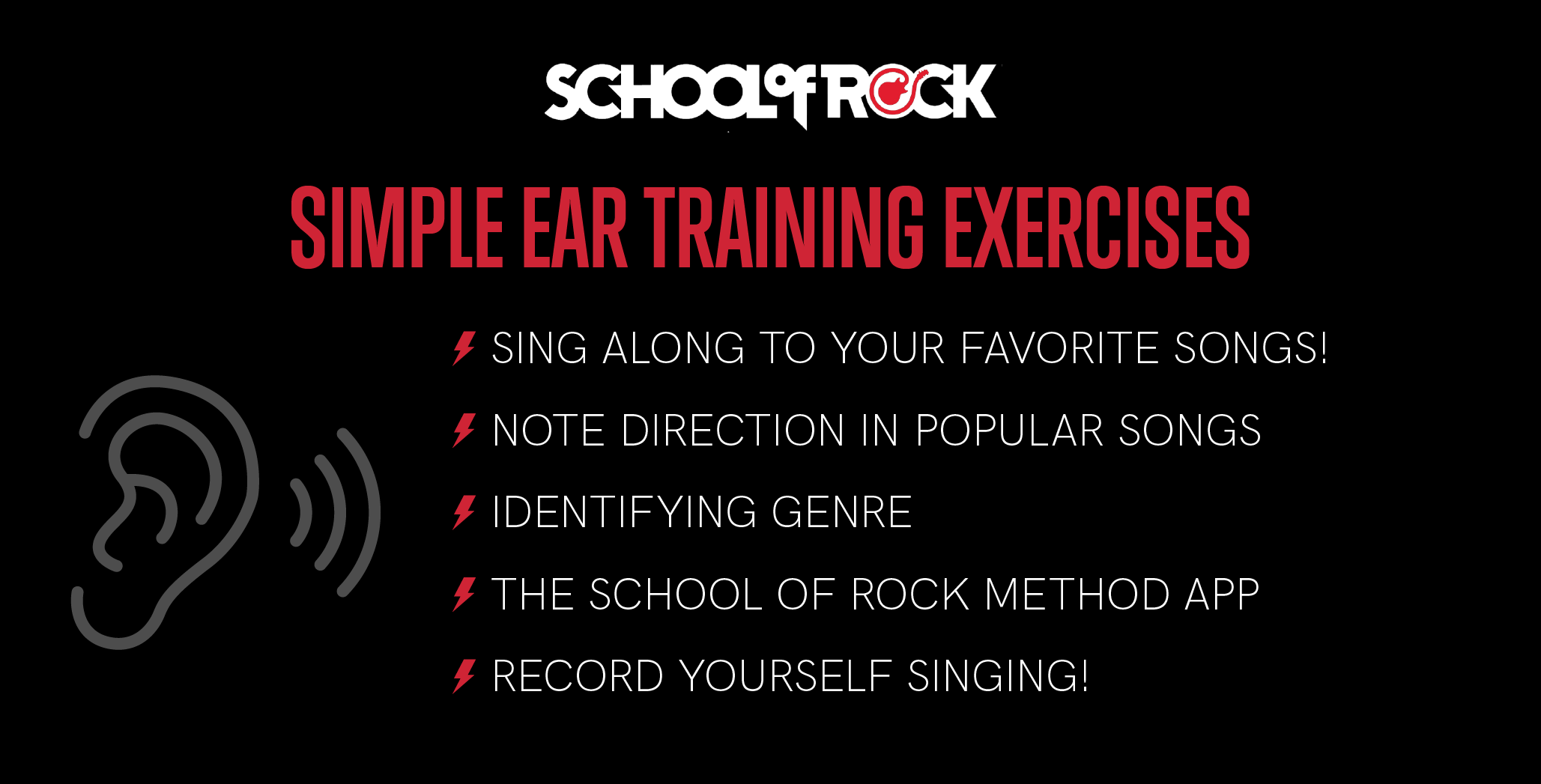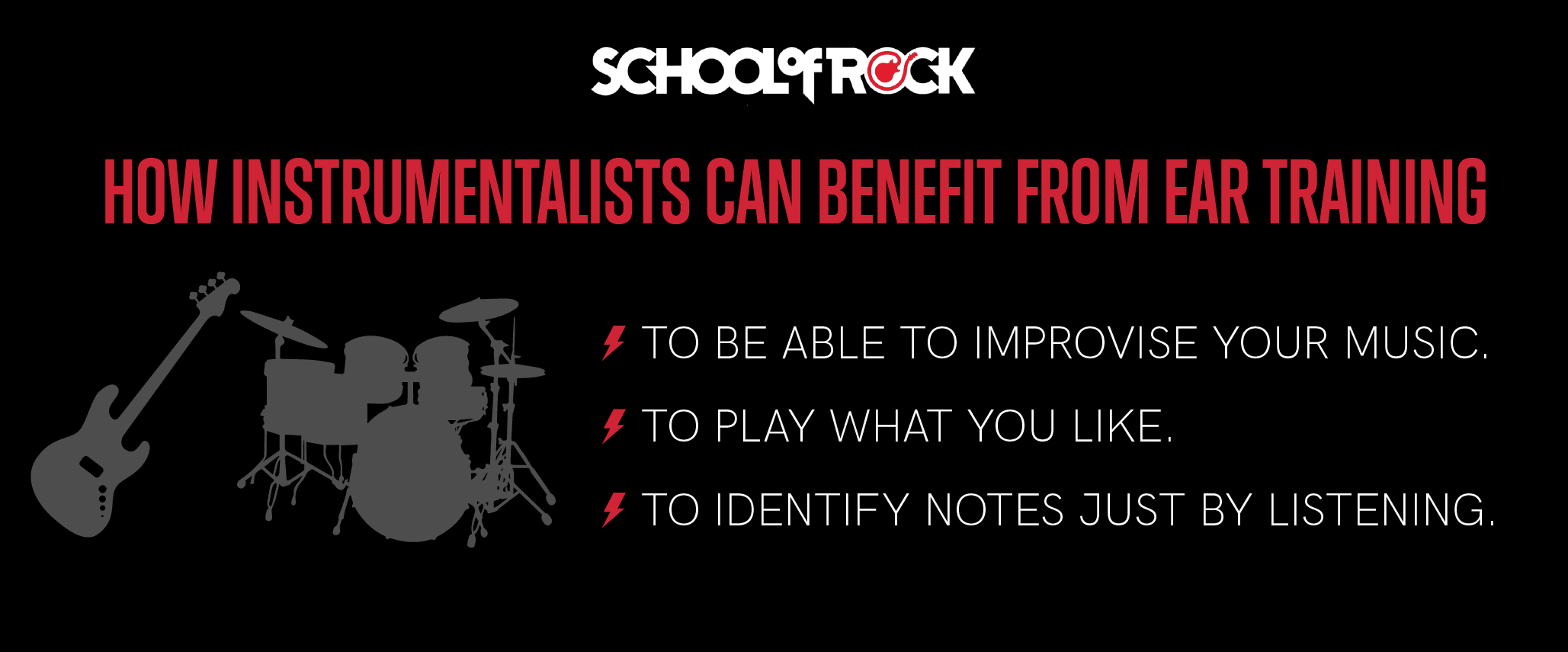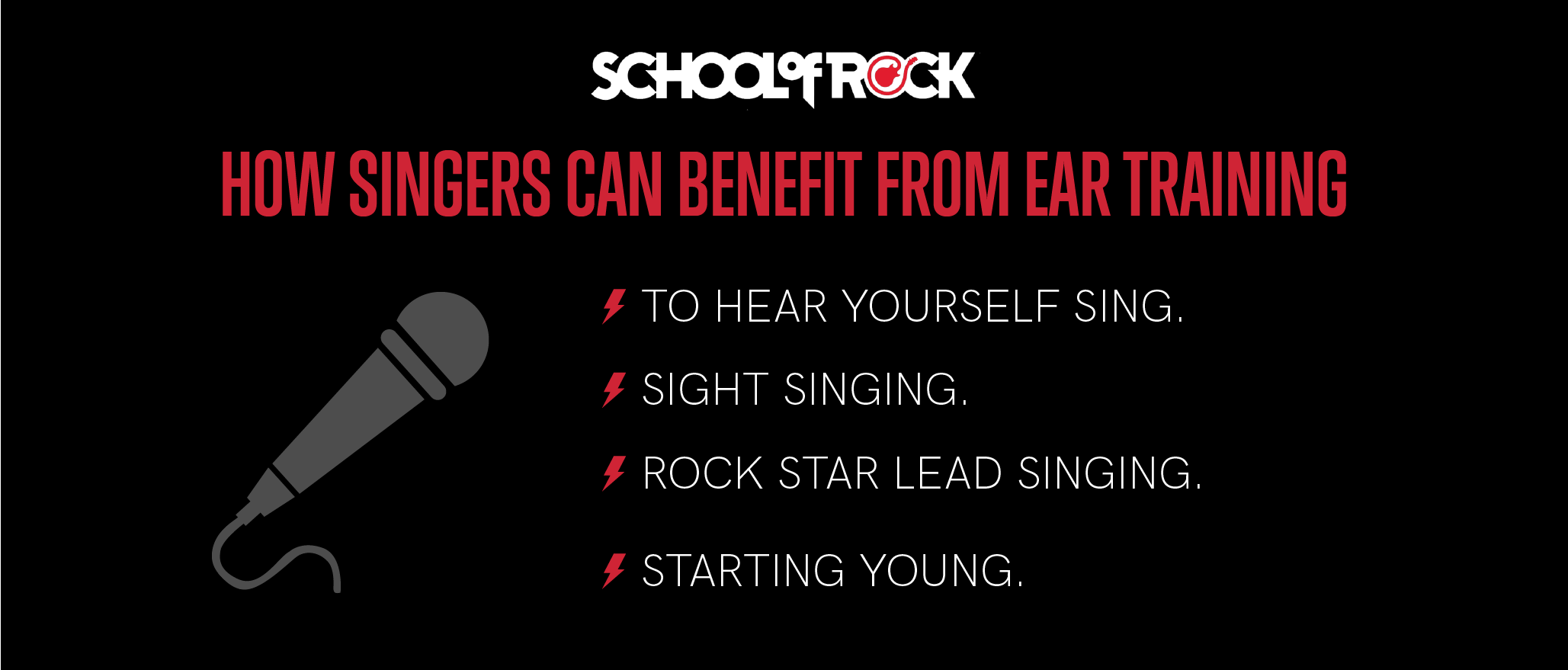Listening critically to the music around us is the best way to become a better musician. Even if you’ve been a passionate music fan your whole life, ear training is a way to engage with your favorite songs in a brand new way and increase your skill level. It’s the secret weapon of a well-trained musician and School of Rock can help facilitate your quest for better ears.

Improve your hearing with these simple ear training exercises
Ear training is the formal practice of being able to identify what you’re listening to. Often referred to as aural skills, ear training is a universal musical skill. Whether it’s hearing melodies, genres, scales, or chord progressions - there are many ways to hone your ears. Ear training is easy to start and there are ways to train regardless of experience level. Whether you’re a parent who wants their child to start their musical journey or a seasoned shredder looking to make solos more tuneful, the path for ear training is similar. All you need is one of your favorite songs and a brief understanding of note direction.
Sing Along to Your Favorite Songs!
What’s more fun than singing along to your favorite songs? It’s something that all fans like to do and can be the foundation of your ear training. When we sing along to songs, we are singing melodies. Melodies are made up of a collection of pitches. Pitches are sounds that are either low, in the middle or high up. Think of a monster's growl as low, an average talking voice as in the middle and your voice after inhaling helium from a balloon as high. With these three categories in mind, think about one of your favorite songs and when you have to sing low, in the middle or high up. Songs that we like to sing mostly contain pitches in the middle with brief stretches in lower and higher ranges to provide contrast. Once you’ve identified the parts of the song that are low, in the middle, or high up the next step is to repeat that process on a more micro level. Within one lyrical phrase are the pitches getting lower, getting higher or staying the same? Pitches (or notes) go in different directions throughout a song. This is noticing note direction and is the first and most important step in your ear training.
Note Direction in Popular Songs
When learning ear training we get to reconsider songs we’ve heard our whole life. Songs like Happy Birthday, Twinkle Twinkle Little Star and the Star Spangled Banner all have unique melodies that help us with ear training. Starting with Happy Birthday, key into the phrase towards the end of the song that goes “happy birthday dear (insert name here).” What you want to notice is the large jump in pitch from “Happy” to the first syllable of “Birthday.” It’s quite a jump! When you sing a song, see if you can notice the highest note you’re singing. You might surprise yourself at how high a given song will take you. Now, try singing Twinkle Twinkle Little Star. Afterwards, give the Alphabet Song a try. Notice anything? They have the same exact tune! This is noticing melody using ear training. Nursery rhymes often have simplistic melodies that are repetitive and limited in range and are a great learning resource at the beginning of your ear training journey. Lastly, the Star Spangled Banner is a good example of a song with a large melodic range. There are low parts, parts in the middle, and parts that are high up. Noticing the range of pitches in songs like the Star Spangled Banner compared to Twinkle Twinkle is listening critically and actively. Keep your ears open for other popular songs and see if you notice anything different with the benefit of ear training.
Identifying Genre
A great way to organize your thoughts when it comes to music is to think about what you're listening to. Understanding the differences of musical genres and having historical context for a particular composition will help you greatly while training your ears. British Heavy Metal from the 80s will have different tones and harmonies than early Chicago Blues. Knowing what to expect from the music you listen to is a great way to limit the playing field of possible sounds and help identify the different parts. Every subgenre has particular traits and sonic trademarks that you can listen for. Understanding these traits is an awesome way to open your ears and evolve your appreciation of music.
The School of Rock Method App
School of Rock has a comprehensive, state-of-the-art App that can facilitate ear training across instruments. When taking music lessons at one of many School of Rock locations, you are assigned specific exercises tailored to your skill level. You are also granted access to learning modules across all instruments. This is a great opportunity to keep your ears open! One of the best ways to train your ears is reading sheet music as you listen to a composition. Try opening up a learning module from the Voice Method Book 1 in the App regardless of your experience level reading music. The only knowledge you need to be aware of when beginning to read music is when the notes (the dots with stems) go up and when the notes go down. This movement corresponds with the differences of pitch you’ll hear. Note direction becomes quickly apparent with a visual accompaniment. Things you may have noticed about music before become much clearer when we follow along and give them labels. The School of Rock Method App is a great way to formalize your ear training and explore past your chosen instrument.
Record Yourself Singing!
A way to increase your sense of pitch is by recording yourself singing. This might be scary or a little embarrassing, but that’s OK! Everyone can sing and there are many ways to get started singing. Hearing yourself is a great way to make your understanding of pitch more tangible. Even if you think you have bad pitch, recording yourself singing is a great way to remedy that. When we sing, we either sing flat (too low), sharp (too high), or in the center of the pitch. We almost always want to sing notes right in their center. If we’re singing and we oscillate between flat and sharp, this can be described as “pitchy,” creating an overall effect that doesn’t sound quite right. Singing in the center of the pitch means making a note sound exactly like what’s in your head. Compare what you hear when you play back the recording of your singing voice to what you want it to sound like in your head. The results might be startling, but it’s a necessary step in realizing how you might need to improve your sense of pitch. One way we encourage you to work on pitch training is through our School of Rock Method App, which allows you to record yourself singing and then scores your pitch for accuracy.

Understanding aural skills and why do they matter?
Why do aural skills matter if you’ve taken lessons your whole life and you’re getting by fine without them? Well, they matter because all musicians use them. Hearing music to understand it is something everyone does, and aural skills are simply enhancements of that understanding. Whether remembering familiar material or exposing ourselves to more adventurous concepts, ear training takes something we already do to the next level.
How instrumentalists can benefit from ear training
All musicians practice and benefit from ear training. A common misconception is that singers are the only musicians who need to practice pitch. Here are concrete ways that ear training will help musicians in their everyday playing:
- To be able to improvise your music. One of the best utilities of ear training is being the superstar of your next jam session. Having your ears open to a few tricks will improve your ability to fit-in during a jam or create more tuneful solos. Identifying key through ear training is the most useful tactic and requires an Intermediate to advanced understanding of ear training.
- To play what you like. Being able to play what you want without relying on a measly tab from the internet makes music much more accessible. Being able to grasp what your teacher is presenting you quickly makes music more engaging. Better ears means learning songs faster and getting to the fun rock star stuff sooner.
- To identify notes just by listening. Identifying key notes like C F and G will give a musician an anchor within the scale. Don’t be discouraged if you can’t identify each note of the chromatic scale by ear, few people can. But having examples of notes you're confident about can be a great advantage.
What is included in ear training sessions?
Ear training has limitless possibilities. It’s a deep and rewarding process with many advanced training techniques. Here are some different aspects of ear training that might suit your style of playing and experience level that you can incorporate into your practice:
1. Perfect pitch ear discovery and training
“Perfect pitch” is a term that is used often, but is more elusive than many think. Musicians who have “perfect pitch” are usually able to sing melodic phrases upon hearing them, identify notes by name and octave, and isolate different instruments within the context of a band setting. An element of “perfect pitch” is achieved through natural talent or early teaching, but just like with any skill, that talent needs to be fostered and cultivated to achieve “perfection.” This label can be discouraging, but don’t let it be! Everyone’s pitch can improve and it’s just a matter of knowing how to listen and practice. Having someone else play an isolated note on their instrument and guessing it’s note name is a good way to test perfect pitch. This is for musicians of an advanced skill level.
2. Ear training for scales and modes
An excellent way to develop your knowledge of music theory and ear training is the identification of scales and modes. The first thing you should do when trying to recall the sound of a certain scale is to remember how it makes you feel. Attaching adjectives and emotions to scales will better help you identify them within a song. Music has a storytelling component, and the notes you hear often tell a story. A major scale is bright and happy compared to a minor scale which is solemn and more dramatic. Don’t be afraid to be descriptive when understanding music. Musicians of any skill level can start hearing the difference in scales. Identifying modes requires advanced ear training and more music theory knowledge.
3. Interval ear training
Many important musical terms are words used in everyday life but with a slightly different and more specific meaning. An interval usually describes the space between two things. In music, an interval is the space between two notes. Two notes can be very close together or really far apart. Having ears for this difference is important. Once you start noticing the space between notes you can learn more about specific intervals and their labels. Going from the first note to the second note in a major scale is called a Major Second. Going from the first note to the third note in a major scale is called a Major Third. Interval Ear Training requires an intermediate understanding of music theory but leads to advanced level understanding.
4. Chord identification ear training
Hearing chords is one of the more difficult aspects of ear training. When you focus your ears to a singer or a guitar playing a melodic line, you are listening to individual notes, isolated one after another. When you listen to harmony, you are hearing chords with notes that play at the same time. It’s pretty obvious why this is harder to identify, but there are many hacks to gain an upper hand when guessing. Start by trying to identify the quality of the chord. Major, minor, diminished, major seven...all chords have specific sonorities and feelings. Being able to distinguish between them in your head is important. Even if you can’t guess the specific notes of a chord, being able to tell what type of chord it might be is a great advantage. The next step when hearing chords is picking out the lowest sounding note. A chord is most likely given its name by its lowest sounding pitch, so being able to identify that pitch will give you contextual information about the rest of a chord. Hear a low sounding C in a chord that sounds bright and pleasing? Chances are the chord is a C major triad and the other notes are E and G! Let your ears do part of the work and your knowledge of music theory fill out the rest of the picture when confronted with difficult harmonies.
5. Chord progression ear training
Chord progression ear training is what gives you superpowers to your non-musician friends. Being able to learn a song just by hearing it, whether it’s picking out the I-IV-V or noticing a key change, amazes those who haven’t identified the repetitive patterns of music. It’s a more advanced area of ear training but essential when playing in group settings. It helps you learn songs much faster and retain the songs you’ve already learned.

How Singers can benefit from ear training
Proper technique and ear training matters for singing. Unlike with other musicians, singers are the instrument. This might sound strange, but when you sing it’s not a matter of pressing the right key or holding down the right fret. You create the sound when you sing so taking care of your body and using proper vocal technique is highly recommended to maximize your potential. Ear training helps singers in unique ways and allows them to thrive in band settings. Here are a few ways to approach singing through ear training that lead to results:
To hear yourself sing. Singing acapella with a group of other singers gives you instant feedback on pitch. Notice how your sound blends with others. See if you can pick out certain singers who are flat or sharp. Make sure to be diplomatic if you tell them, pitch can be a touchy subject!
Sight Singing. Singing melodies you’re unfamiliar with is a great way to practice the retention of sound. Try to get every tune you’re learning “stuck in your head.” If you’re proficient at reading music, try singing pitches on sight in a new composition or after only hearing it a few times. Training Modules in the School of Rock Method App is great for this practice. Sight singing can get very advanced if you choose melodies with chromatic notes and wide vocal ranges.
Rock Star Lead Singing. Being a singer in a rock band means leading the way. Listen to other instruments when you're singing in band practice. Notice when your pitch is harmonized with the guitar. Notice if a band member might be out of tune. A lead singer with a command of musical concepts and trained ears makes band practice better for everyone.
Starting Young. These concepts of ear training have a great chance of sticking if you start learning them at a young age. Music is just like learning a foriegn language. If you practice a lot while you’re young there's a better chance that these concepts become second nature.
Eager to get started? Set up a routine
Ear training is just like going to the gym. Don’t expect to get swole by going all out once a month! Ear training is like strengthening a muscle and will not be greatly improved by binging or cramming. Ear training must be approached patiently with a steady practice routine if you want to see substantial results. Practicing 20-30 minutes a day doing the aforementioned activities that suit your skill level will go a long way. We listen to sounds all day and opening our ears and learning how to listen is a great way to start growing as a musician for as long as we play music.
ABOUT THE AUTHOR
Shane Burbage is an instructor at School of Rock Raleigh.




